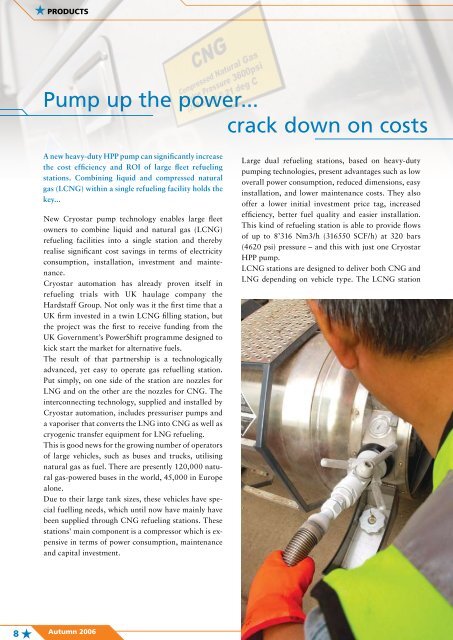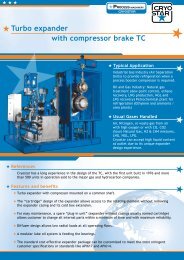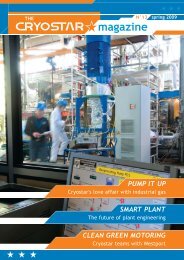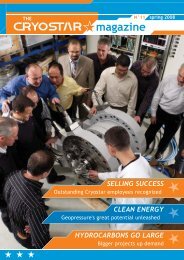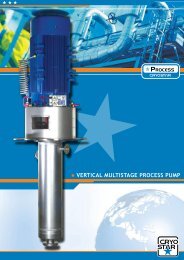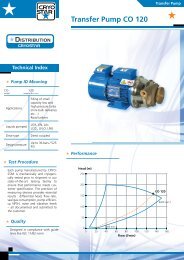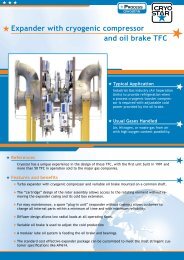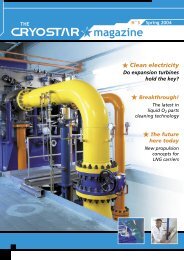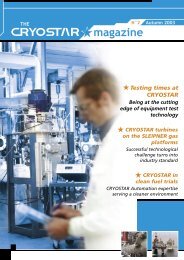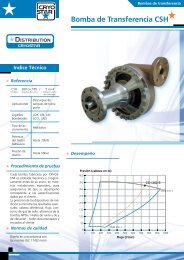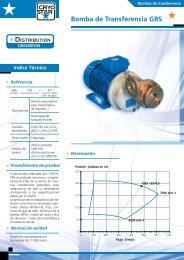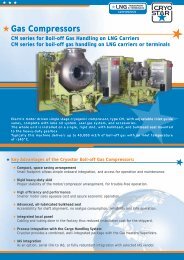The Cryostar Magazine N°8
The Cryostar Magazine N°8
The Cryostar Magazine N°8
- TAGS
- cryostar
- magazine
- cryostar.com
You also want an ePaper? Increase the reach of your titles
YUMPU automatically turns print PDFs into web optimized ePapers that Google loves.
PRODUCTS<br />
Pump up the power...<br />
crack down on costs<br />
A new heavy-duty HPP pump can significantly increase<br />
the cost efficiency and ROI of large fleet refueling<br />
stations. Combining liquid and compressed natural<br />
gas (LCNG) within a single refueling facility holds the<br />
key...<br />
New <strong>Cryostar</strong> pump technology enables large fleet<br />
owners to combine liquid and natural gas (LCNG)<br />
refueling facilities into a single station and thereby<br />
realise significant cost savings in terms of electricity<br />
consumption, installation, investment and maintenance.<br />
<strong>Cryostar</strong> automation has already proven itself in<br />
refueling trials with UK haulage company the<br />
Hardstaff Group. Not only was it the first time that a<br />
UK firm invested in a twin LCNG filling station, but<br />
the project was the first to receive funding from the<br />
UK Government’s PowerShift programme designed to<br />
kick start the market for alternative fuels.<br />
<strong>The</strong> result of that partnership is a technologically<br />
advanced, yet easy to operate gas refuelling station.<br />
Put simply, on one side of the station are nozzles for<br />
LNG and on the other are the nozzles for CNG. <strong>The</strong><br />
interconnecting technology, supplied and installed by<br />
<strong>Cryostar</strong> automation, includes pressuriser pumps and<br />
a vaporiser that converts the LNG into CNG as well as<br />
cryogenic transfer equipment for LNG refueling.<br />
This is good news for the growing number of operators<br />
of large vehicles, such as buses and trucks, utilising<br />
natural gas as fuel. <strong>The</strong>re are presently 120,000 natural<br />
gas-powered buses in the world, 45,000 in Europe<br />
alone.<br />
Due to their large tank sizes, these vehicles have special<br />
fuelling needs, which until now have mainly have<br />
been supplied through CNG refueling stations. <strong>The</strong>se<br />
stations’ main component is a compressor which is expensive<br />
in terms of power consumption, maintenance<br />
and capital investment.<br />
Autumn 2006<br />
Large dual refueling stations, based on heavy-duty<br />
pumping technologies, present advantages such as low<br />
overall power consumption, reduced dimensions, easy<br />
installation, and lower maintenance costs. <strong>The</strong>y also<br />
offer a lower initial investment price tag, increased<br />
efficiency, better fuel quality and easier installation.<br />
This kind of refueling station is able to provide flows<br />
of up to 8’316 Nm3/h (316550 SCF/h) at 320 bars<br />
(4620 psi) pressure – and this with just one <strong>Cryostar</strong><br />
HPP pump.<br />
LCNG stations are designed to deliver both CNG and<br />
LNG depending on vehicle type. <strong>The</strong> LCNG station


